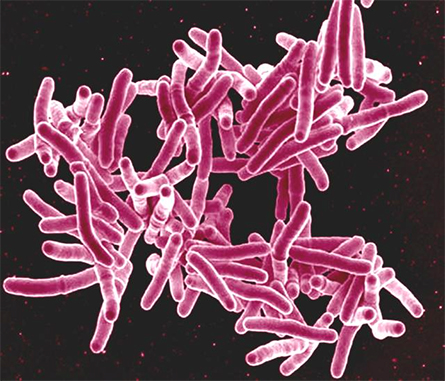From the journals: JBC
Defining functional redundancy in mycobacteria. Finding aqueous pores in sodium channels. Identifying new substrates for a ubiquitin ligase. Read about papers on these topics recently published in the Journal of Biological Chemistry.
Functional redundancy in mycobacteria
The tricarboxylic acid, or TCA, cycle is essential to carbon metabolism. Malate oxidation, a critical step of this cycle, is catalyzed by malate dehydrogenase or malate quinone oxidoreductase. These enzymes, Mdh and Mqo, respectively, tend to co-occur in a single bacterium, and one of them is usually primarily responsible for malate oxidation. Although these proteins are present in most bacteria, the level of functional redundancy remains unclear.

which cause TB.
In a recent article in the Journal of Biological Chemistry, Liam Harold and collaborators from the University of Otago in New Zealand describe performing a bioinformatic survey of thousands of bacterial proteomes that revealed that Mqo was not as widespread as Mdh in bacteria and that it was highly conserved in mycobacteria.
The authors deleted mqo from Mycobacterium smegmatis, an environmental saprophyte — that is, it feeds on decaying matter — that lacks Mdh in its genome and found that Mqo is essential for growth on nonfermentable carbon sources. The authors also determined that mqo mutants grew more slowly on fermentable carbon sources. Complementation experiments with a heterologous Mdh from Mycobacterium tuberculosis shortened the delayed growth on fermentable carbon sources and restored growth on nonfermentable carbon sources at a reduced growth rate.
The authors conclude that Mdh is maintained in slow-growing mycobacterial pathogens for use under conditions such as hypoxia that require reductive TCA cycle activity.
Finding aqueous pores in sodium channels
Epithelial Na+ channels, or ENaCs, belong to the (ENaC)/degenerin family, and their extracellular domains interact with ohter factors that regulate channel gating. These channels influence such functions as blood pressure and vascular smooth muscle and are composed of three subunits: alpha, beta and gamma.
Several studies have identified specific amino acid residues and extracellular domain structures that regulate ENaC gating; however, researchers do not yet understand the transitions that happen at a structural level. In a recent Journal of Biological Chemistry article, Lei Zhang and collaborators at the University of Pittsburgh describe using cysteine, or Cys, scanning mutagenesis to better understand the functional effects of Cys-modifying reagents on palm domain β10 strand residues in mouse ENaC.
The authors show that only mutants in the proximal region of β10 exhibited changes in channel activity in response to methanethiosulfonate reagents. In addition, multiple Cys mutants were activated by low concentrations of thiophilic Cd2+. The researchers also identified four alpha, two beta and two gamma subunit β10 strand mutations that changed the Na+ self-inhibition response.
The authors state this model is consistent with the structure of mouse ENaC that predicts the presence of aqueous tunnels adjacent to the proximal part of β10.
IDing new substrates for a ubiquitin ligase
The HECT E3 ligase WWP2 targets lysine residues for ubiquitination in a broad range of proteins involved in different physiological processes. WWP2 is made up of an N-terminal C2 domain, four central WW domains and a C-terminal catalytic HECT domain. The linker peptide between the middle WW domains can autoinhibit the catalytic domain of this protein, and this inhibition can be removed by phosphorylation at the tyrosine residue at position 369. Researchers have yet to determine the range of substrates and functions of WWP2.
In a recent article in the Journal of Biological Chemistry, Hanjie Jiang and collaborators at Brigham and Women’s Hospital describe using protein microarray technology as a platform to identify WWP2 substrates using an activated version of this ligase. This technology can assess enzyme-substrate interactions directly in a high-throughput fashion.
The authors identified several substrates, of which they validated three well-known autophagy receptors using cell-based transfection assays, and the lysine ubiquitination sites on these proteins were mapped by mass spectrometry. The authors conclude that WWP2-mediated ubiquitination of the autophagy receptors may contribute positively to the regulation of autophagy.
Enjoy reading ASBMB Today?
Become a member to receive the print edition four times a year and the digital edition monthly.
Learn moreGet the latest from ASBMB Today
Enter your email address, and we’ll send you a weekly email with recent articles, interviews and more.
Latest in Science
Science highlights or most popular articles

Bacteriophage protein could make queso fresco safer
Researchers characterized the structure and function of PlyP100, a bacteriophage protein that shows promise as a food-safe antimicrobial for preventing Listeria monocytogenes growth in fresh cheeses.

Building the blueprint to block HIV
Wesley Sundquist will present his work on the HIV capsid and revolutionary drug, Lenacapavir, at the ASBMB Annual Meeting, March 7–10, in Maryland.

Gut microbes hijack cancer pathway in high-fat diets
Researchers at the Feinstein Institutes for Medical Research found that a high-fat diet increases ammonia-producing bacteria in the gut microbiome of mice, which in turn disrupts TGF-β signaling and promotes colorectal cancer.

Mapping fentanyl’s cellular footprint
Using a new imaging method, researchers at State University of New York at Buffalo traced fentanyl’s effects inside brain immune cells, revealing how the drug alters lipid droplets, pointing to new paths for addiction diagnostics.

Designing life’s building blocks with AI
Tanja Kortemme, a professor at the University of California, San Francisco, will discuss her research using computational biology to engineer proteins at the 2026 ASBMB Annual Meeting.

Cholesterol as a novel biomarker for Fragile X syndrome
Researchers in Quebec identified lower levels of a brain cholesterol metabolite, 24-hydroxycholesterol, in patients with fragile X syndrome, a finding that could provide a simple blood-based biomarker for understanding and managing the condition.

